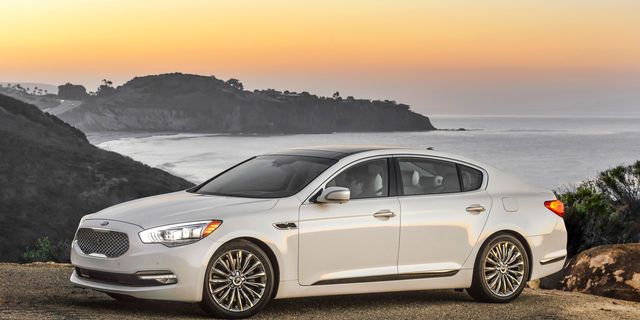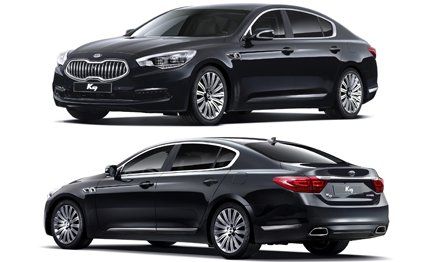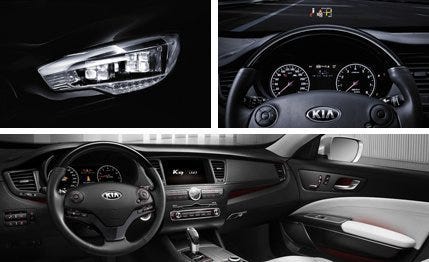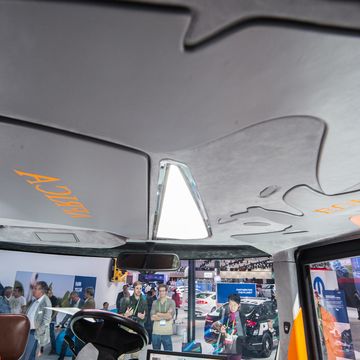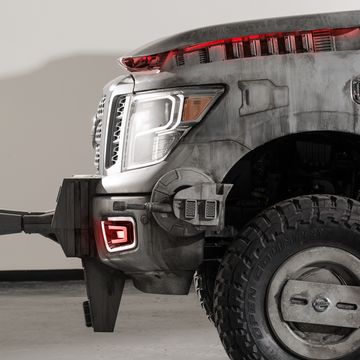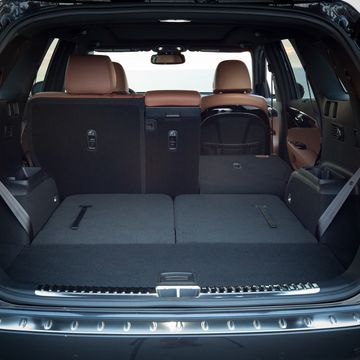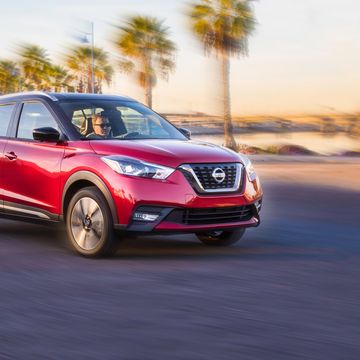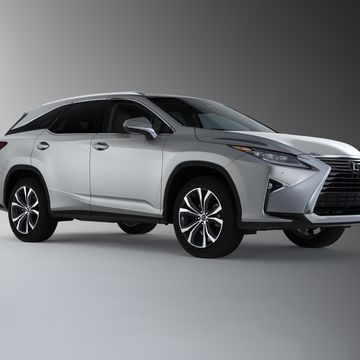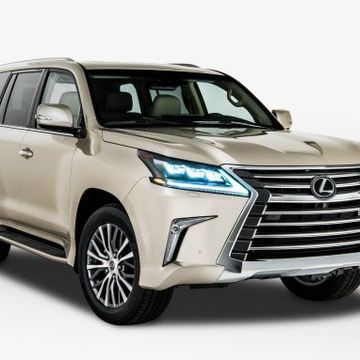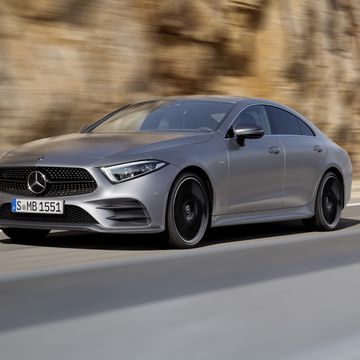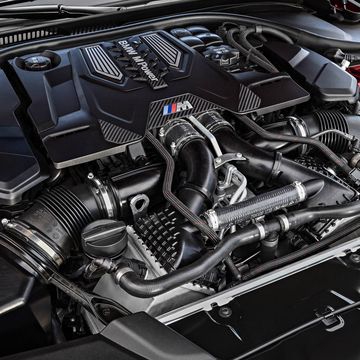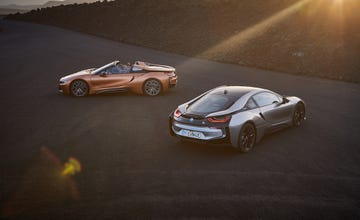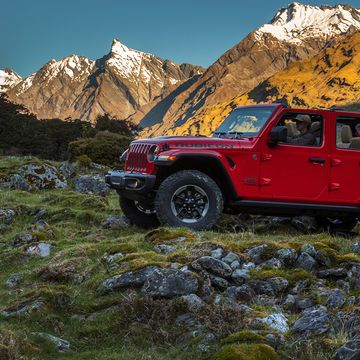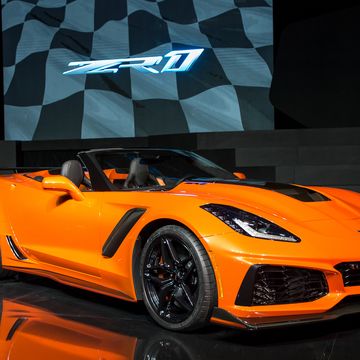As Kia debuts the K900—its first-ever true luxury sedan—at the 2013 L.A. auto show, the automaker asks that you consider how far it has come since entering the U.S. market 20 years ago. Looking at the K900’s spec sheet, and then at its rich styling and rear-drive layout, and then its spec sheet again, it’s easy to drink Kia’s self-congratulatory Kool-Aid. After all, this is a brand that started out building bicycles in Korea in the 1950s, and then launched itself stateside with the dreary Sephia sedan in 1994. Now, the K900 arrives in the U.S. with the mission of fortifying Kia’s luxury aspirations, its arrival paved by recent, incremental moves upmarket with the Optima Limited and Cadenza sedans.
More Than a Rolling Warranty with Leather
The K900, which is already on sale in Korea, leaves Kia’s womb a fraternal twin, paired architecturally as it is with Hyundai’s rear-drive Genesis sedan. Although there are traces of the Genesis in the K900’s general proportions, the look is pure Kia, and in a good way. Under the guidance of Peter Schreyer, Kia’s design department has been on a roll of late, and the K900 continues that trend. Overall, the sedan is clean and well-tailored, even if the headlights and taillights mimic those of BMW’s 5- and 7-series a bit too accurately. Fine details abound, such as the pinched side-vent shape that mimics the grille and Kia’s attractive “soft LED” head- and taillight accents. To our eyes, the only heavy-handed styling element is the chunky chrome strip that runs above the rocker panels and is picked up on the outboard edges of the rear bumper.
Besides sharing its basic underlying structure with the Genesis, the K900 also inherits that car’s direct-injected V-6 and V-8 engines. The base V-6 Premium model is powered by a 3.8-liter V-6, while the V-8 Premium gets the 5.0-liter “Tau” V-8 from the Genesis R-Spec model. Both engines make less power here than they do in the corresponding Hyundai; at 311 and 420 horsepower, they’re down by 22 and 9 horses. Both engines back up to an eight-speed automatic transmission. Dimensionally, the K900 is larger than the Genesis, with its 119.9-inch wheelbase stretching 4.3 inches beyond the Hyundai’s, and it’s also 4.3 inches longer, .4 inch wider, and about half an inch taller. Interior dimensions mirror the Hyundai’s, although Kia managed to squeeze an additional 1.8 cubic feet of interior volume out of the K900, for a total of 110.8.
The Kitchen Sink
The K900 is a far cry from the economy Kia vehicles of yore, yet it also continues the brand’s more-for-less value scheme with an eye-wateringly long list of standard equipment. Indeed, both models include many items that are optional on more expensive cars. The list includes 18-inch wheels, HID headlights, LED fog lights and taillights, rain-sensing wipers, keyless entry and start, heated power-folding side mirrors, a power-closing trunk, leather (seats, dashboard, door panels, and steering wheel), a 9.2-inch central display with navigation, a backup camera, and front and rear parking sensors. But wait, as insane dudes on TV say, there’s more. The K900 also packs a 900-watt, 17-speaker Lexicon audio system; three-zone climate control; heated and ventilated 12-way power front seats; heated outboard rear seats, and a power rear sunshade.
The V-8 does add a few niceties beyond its bigger engine, including 19-inch chrome rollers, LED headlights, a panoramic sunroof, rear cross-traffic alert, blind-spot monitoring and lane-departure warning systems, and a heated leather-and-wood steering wheel. Final pricing has yet to be announced, but figure on a starting price in the upper $40,000 range to give the Cadenza some breathing room.
A pair of option packages, dubbed Luxury and Technology, will be available to V-6 buyers, although getting the latter requires ordering the former. The Luxury package includes a shift-by-wire gear selector (the stock V-6 gets a cable-operated setup), Nappa leather seat trim, a more upscale headliner, a heated leather-and-wood steering wheel, and genuine wood trim. The Tech package adds the V-8’s additional standard equipment (16-way driver’s seat and proximity safety tech) as well as a collision warning system, adaptive cruise control, soft-close power-closing doors, power front-seat headrests, and a full-color head-up display. The V-8’s options list is limited to one item: the aptly named “VIP package.” It brings everything you’ve already read about, plus power reclining rear seats with ventilation, an extendable driver’s seat cushion, a 12.3-inch digital gauge cluster, a pre-crash system, and a 360-degree camera.
So, yeah, the K900 will have everything it needs to compete with other mid- to large-size luxury cars—except a revered luxury nameplate. Like the Genesis, the K900 represents Kia’s coming of age as an automaker, but it’s going to take more than competence and equipment to court the typically badge-conscious buyers in this price arena. We’re told the Genesis was most often purchased by people entering the luxury market for the first time— Hyundai calls these “intercepts”—as well as those who prefer not to flaunt their financial status. It seems to us that the K900 will court these same people, which could make for some awkward conversations around Hyundai/Kia global HQ.
While we won’t know for sure until we drive it, the K900 seems poised to provide a satisfying capper to Kia’s U.S. lineup, at least until the production version of the sporty, rear-drive GT concept arrives—that’s one Kia we can’t wait to see. (Could you imagine saying that 20 years ago?)

